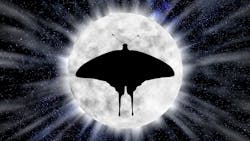Study shows excess light impacts caterpillar population
Scientists studying the effect of outdoor lighting on moth caterpillars in about 30 areas in England have concluded that the illumination is generally bad for the insects, with the broader-spectrum LED lights generally worse than the more limited spectrum but still harmful high-pressure sodium (HPS) and low-pressure sodium (LPS).
A team from three institutions observed hedgerows and grass margins across three counties — Oxfordshire, Buckinghamshire, and Berkshire — examining moth populations under existing LED and sodium street lights, and comparing them to populations in nearby unlit patches.
The team also installed lighting in previously unlit habitats and monitored the impact.
In both instances, the caterpillars suffered due to the artificial light at night or “ALAN” in the nomenclature of the paper published in the journal Science Advances.
“We found that street lighting strongly reduced moth caterpillar abundance compared with unlit sites (47% reduction in hedgerows and 33% reduction in grass margins) and affected caterpillar development,” wrote the researchers from the Wallingford-based UK Centre for Ecology & Hydrology, from Newcastle University’s School of Natural and Environmental Studies, and from Butterfly Conservation, based in Wareham. “A separate experiment in habitats with no history of lighting revealed that ALAN disrupted the feeding behavior of nocturnal caterpillars. Negative impacts were more pronounced under white light-emitting diode (LED) street lights compared to conventional yellow sodium lamps. This indicates that ALAN and the ongoing shift toward white LEDs (i.e., narrow- to broad-spectrum lighting) will have substantial consequences for insect populations and ecosystem processes.”
The researchers postulated that that the impact was higher in the hedgerows than in the grass margins because the hedgerows were subject to higher lux levels, being closer to the street lights.
Breaking down the effect by lighting technology, the authors noted that in hedgerows, the population hit was 52% under LED and 41% under HPS. They did not state a figure for LPS. On grass margins, the population decline was 43% under LED, 24% under HPS, and 11% under LPS.
The lights, especially the LEDs, appeared to make the caterpillars grow larger (the study implies that this is detrimental). “Moth caterpillars sampled from lit (sections) were typically heavier than those from unlit areas, likely because ALAN heightened developmental rates,” according to the authors, led by Douglas Boyes, who is affiliated with all three groups. They described this effect as “significant” under LED, “mixed” under HPS and “nonsignificant” under LPS.
Meanwhile over in the newly lit habitats, the moths also fared poorly.
“In a separate experiment, we erected lighting rigs along homogeneous, previously unlit grass field margins 1 hour before sunset,” the authors explained. “Sampling was conducted between 1 and 2 hours after dusk to test whether ALAN disrupted the normal feeding behavior of nocturnal caterpillars.” It did, as “fewer caterpillars” were detected under the LED lights compared to unlit areas. However, “there was no statistically significant difference under HPS lights.” the scientists stated.
Under the LED lights in the short-term lit field margins, the caterpillars ate less than in unlit areas. The authors suggested that the blue spectrum might have tricked the caterpillars into thinking it was daytime (when natural light is more blue-rich) and thus they did not climb grass stems to eat like they normally do once the evening arrives and the blue fades. The newly lit areas had a higher blue intensity than the existing street lights.
The authors noted that the caterpillars could be used as a proxy for other insects. In general, their findings backed up an observation in their introduction.
“Light pollution is increasing globally and encroaching on biodiversity hot spots,” they state at the outset of their paper in which they reference earlier studies on lighting’s effect on pollination. “At the same time, the spectral composition of outdoor lighting is rapidly changing, with broad-spectrum light-emitting diodes (LEDs) increasingly being favored because of their higher energy efficiency. The consequences of this shift are unknown, but it is predicted that white broad-spectrum LEDs have greater potential for ecosystem disruption, based on the visual sensitivities of many taxa, including nocturnal insects. These same studies suggest that narrower-spectrum lighting (e.g., sodium lamps, which emit mostly yellow light) may be less harmful to biological processes.”
LEDs Magazine noted recently that LED lighting at a Belgian tomato greenhouse was discouraging pollination activity among bees, although other studies have suggested a positive pollination effect. We will continue to report on findings in this area.
Eco-friendly lighting case studies
Holland’s newest red-light district is a big boost for bats
Turtles hatch to warm LEDs on Alabama’s gulf coast
The LED street lights on this North Sea island are for the birds
Sea turtles thrive with amber LED lighting and dark sky advocates rejoice
MARK HALPER is a contributing editor for LEDs Magazine, and an energy, technology, and business journalist ([email protected]).
For up-to-the-minute LED and SSL updates, why not follow us on Twitter? You’ll find curated content and commentary, as well as information on industry events, webcasts, and surveys on our LinkedIn Company Page and our Facebook page.

Mark Halper | Contributing Editor, LEDs Magazine, and Business/Energy/Technology Journalist
Mark Halper is a freelance business, technology, and science journalist who covers everything from media moguls to subatomic particles. Halper has written from locations around the world for TIME Magazine, Fortune, Forbes, the New York Times, the Financial Times, the Guardian, CBS, Wired, and many others. A US citizen living in Britain, he cut his journalism teeth cutting and pasting copy for an English-language daily newspaper in Mexico City. Halper has a BA in history from Cornell University.





